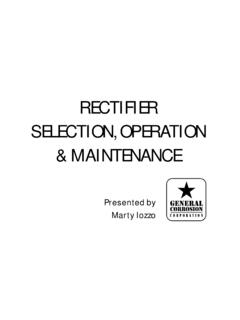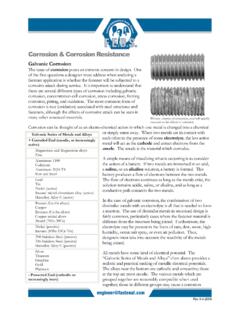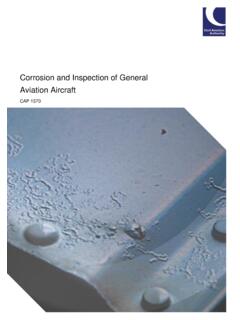Transcription of EXPERIMENT #9 CORROSION OF METALS
1 EXPERIMENT #9 CORROSION OF METALS Objective The objective of this EXPERIMENT is to measure the CORROSION rate of two different METALS and to show the effectiveness of the use of inhibitors to protect METALS from CORROSION . Background The importance of CORROSION can be seen in daily life. CORROSION causes accidents in industry, on highways, and in homes. It is wasteful financially, costing industrialized nations 4-5% of their gross domestic products annually. A little knowledge of electrochemistry, material science and CORROSION could save nations some 25% of this loss. CORROSION engineering is the application of science and art to prevent or control CORROSION damage in a safe and economical manner. To perform this function properly, the CORROSION engineer must rely on experimental research. This is because the major aspects of CORROSION engineering are largely empirical in nature. A body of theory exists that can be very helpful in solving CORROSION problems, but in the final analysis, most decisions are based on the results of empirical tests.
2 CORROSION tests are conducted for a number of reasons including: 1. Establishing CORROSION mechanisms. 2. Defining CORROSION resistance of materials and how to develop new CORROSION resistant alloys. 3. Estimating service life of equipment. 4. Developing CORROSION protection processes. 5. Defining the critical potential values for materials in various environments. Theory Anodes and Cathodes: In analyzing CORROSION , the first thing that must be determined is whether a metal reacts with its environment. If so, the nature of the reaction must be understood. It is generally accepted that CORROSION processes are caused by the formation of electrochemical cells. The electrochemical reactions in these cells can be divided into two reactions: 1. Anodic reactions 2. Cathodic reactions where each reaction is called a half-cell reaction. In the anodic reaction, metal goes into solution as an ion. The reaction is generally written as: M --> Mn+ + ne- where M is a metallic element, e- is an electron and n is the valence of the metal as an ion.
3 An example of this is Zinc where: Zn --> Zn2+ + 2e- In the cathodic reaction, electrons provided by the anode, flow through the metal until they reach the cathode where they can be combined with positively charged ions. In acidic solutions this reaction is: 2H+ + 2e- --> 2H --> H2(gas) and in neutral solutions the reaction is: O2 + 2H2O + 4e- --> 4OH- Both the anodic and cathodic reactions must occur simultaneously for a CORROSION process to proceed. If both reactions are not occurring then a charge builds up and the CORROSION process stops. The anodic reaction is generally the simple case of a metal going into solution. However a variety of cathodic reactions are encountered depending on the conditions of the process involved. Table 1 shows several examples of different cathodic reactions. Note that in all of the cathodic reaction electrons are absorbed. Table 1 - POSSIBLE CATHODE REACTIONS IN DIFFERENT GALVANIC CELLS Cathode Reaction Example 2H+ + 2e- --> 2H Acid Solutions O2 + 2H2O + 4e- --> 4OH- Neutral and alkaline solutions O2 + 4H+ + 4e- --> 2H2O Using both O2 and H+ in acid solutions M3+ + e- --> M2+ When Ferric ions are reduced to ferrous M2+ + 2e- --> MO When iron is placed in a Cu salt solution the electron from solution of the iron reduces Cu ions to metallic Cu The electrode potential in the electrochemical cell When an ideal metal is placed in an electrolyte.
4 An electrode potential develops that is related to the tendency of the material to give up electrons. To measure this tendency, we measure the potential difference between the metal and a standard electrode using a half-cell. The standard reference electrode is a half cell with a known constant potential. Different standard reference electrodes are used depending on the solution environment. Some standard electrodes are the standard hydrogen electrode (SHE) and the saturated calomel electrode (SCE). Standard expressions for CORROSION rate In most cases, aside from contamination problems, the primary concern where CORROSION is present, is the life (usually in years) of METALS in question. A good CORROSION rate EXPERIMENT should include: 1. Familiar units. 2. Easy calculations with a minimum opportunity for errors. 3. Ready conversion of data to life in years. 4. Penetration. 5. Whole numbers without cumbersome decimals.
5 Mils penetration per year (mpy) is the most commonly used CORROSION rate expression in the United States. One formula used to calculate the CORROSION rate is: 534 x W mpy = D x A x T where, W = weight loss (gms) D = density of the specimen, g/cm3 A = area of specimen, sq. in. T = exposure time, hr. The CORROSION rates of resistant materials generally range between 1 and 200 mpy. The relative CORROSION resistance of a material can be evaluated using the following criteria: Relative CORROSION Resistance mpy outstanding <1 excellent 1-5 good 5-20 fair 20-50 poor 50-200 unacceptable >200 Consider a car engine block with and without the addition of antifreeze, as an example of a CORROSION rate problem. Engine blocks are generally made from low carbon steel that corrodes when exposed to tap water.
6 This is the brown rust that is often seen in cooling systems containing water only. The CORROSION reactions for low carbon steel are: Fe --> Fe2+ + 2e- Fe2+ --> Fe3+ + e- O2 + 2H2O + e- --> 4OH- 2Fe + 2H2O + O2 --> 2Fe2+ + 2OH- --> 2Fe(OH)2 2Fe(OH)2 + H2O + 1/2 O2 --> 2Fe(OH)3 (rust) The electrochemical technique is used to study the CORROSION rate of low carbon steel in tap water instead of using the weight loss technique. This is because the former is a very rapid method of obtaining data while the latter technique is a very lengthy process. In the electrochemical process the CORROSION rate is measured by measuring the current density, J: I J = A where I is the current in microamps ( A) and A is the area in cm2. The CORROSION rate can be calculated from this using the relationship: 1 mpy = (1/n ) J where n is the valence of the metal involved (M --> Mn+ + ne-).
7 PROCEDURE CAUTION: BE SURE YOU UNDERSTAND HOW TO OPERATE THE EQUIPMENT BEFORE BEGINNING THE EXPERIMENT If you are not familiar with the equipment ask for help from your instructor. DO NOT START INDISCRIMINATELY MAKING ADJUSTMENTS TO THE EQUIPMENT. Your group will be provided with samples of 1018 steel and brass. Prepare the sample (metal exposed side) for metallographic observation (polish/grind using 400 grit, 600 grit sandpaper and 1 micron powder). Check the specimens under the microscope to be sure that they are well polished. Observe the surface of each specimen before and after CORROSION takes place. Take photos. CAUTION: The equipment used to measure CORROSION rates is very delicate. Use extreme care when handling. Pour about 400cc tap water (room temperature) into the beaker that makes up the electrochemical cell and add approximately one teaspoon of salt to form a solution.
8 Then place one prepared (steel or brass) specimen in the cell setup with the calomel standard reference electrode and the counter electrode. Check to be sure that the counter electrode and the sample surface are parallel (not touching). Connect the leads from the EG&G VersaStat to the electrochemical cell. The Green wire attaches to the working electrode (the sample), the Red wire attaches to the counter electrode, and the White wire attaches to the reference electrode. If the machine is not already on, boot up the computer and at the DOS C:\> prompt type: corr [ENTER]. When the title screen comes up hit any key to display the Main menu. Pick SetUp from the main menu to display the Set up menu. Pick Get Set Up . You will then be asked to Enter setup filename for recall. Type: 227L [ENTER]. The screen will now display the test parameters to be used for your EXPERIMENT . Your group will have to enter the correct sample area and specimen density in their respective fields on the test Setup Screen.
9 Once the correct test parameters have been entered for your specimen, your group is ready to run a test. Choose the Run command from the menu and turn the Cell Switch located on the front of the EG&G Versa Stat to the ON position. A plot of your test will appear on the computer screen once the test begins. The test runs for 15 minutes. When the test stops, turn the Cell Switch to the OFF position. Save your data to a floppy before beginning any further tests. Put a floppy disk into the A drive. To save your data first save your data on the C drive using the Save command in the File menu. Next recall your data using the Get Data command in the File menu. Finally, transfer the data to your diskette in the A drive by choosing the Export Data from the File menu. Type in a file name for your data including an A drive path. (For example, you can type: a:\steel).
10 Repeat this procedure for the other metal (steel or brass) sample. Next put about 400cc of the prepared antifreeze/water mixture (50% ethylene glycol) into the electrochemical cell and repeat the EXPERIMENT for the remaining samples. Note the CORROSION inhibiting effect of the antifreeze. Normally, when antifreeze is added in small concentrations to an environment, the CORROSION rate decreases. In a sense, an inhibitor can be considered a retarding catalyst. The effectiveness of an inhibitor can be measured based on: CORROSION rate without inhibitor Degree of effectiveness of inhibitor = CORROSION rate with inhibitor when a rate is determined using the mpy equation once the rate has plateaued. Glossary of Terms Understanding the following terms will help in understanding this EXPERIMENT . Anode. The electrode in an electrochemical cell that oxidizes, giving up electrons to an external circuit and ions into solution during CORROSION .















![Corrosion Protection.ppt [Read-Only] - University of Iowa](/cache/preview/1/c/f/9/2/e/d/5/thumb-1cf92ed5cf903dbf2b6cd3a840081a01.jpg)


